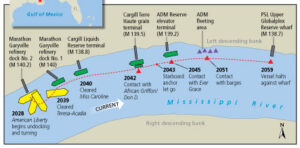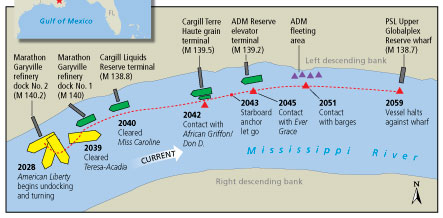Federal investigators determined that “higher-than-average current speed” was a contributing factor in a New Year’s Day bridge strike on the Des Plaines River southwest of Chicago.
The 1,200-hp towboat William C. was downbound with six loaded barges when the pilot lost control while lining up for the third bridge transit in a half-mile. The lead two barges struck a protection cell for the Rock Island Railroad Bridge at 0032. The bridge is located at Des Plaines River mile 287.6, near downtown Joliet, Ill.

The impact caused more than $500,000 in damage, mostly to the bridge. The two lead barges that hit the protection cell sustained minor damage. None of William C’s six crewmembers was injured.
Investigators with the National Transportation Safety Board (NTSB) determined the faster-than-normal current contributed to the towboat pilot’s “inability to correct the tow’s position after completing the transit through the previous bridge.”
“When the pilot determined there was not enough time to move the vessel in order to avoid striking the bridge, he reversed both engines … which reduced the force of the impact but did not prevent the barges from hitting the bridge’s protection cell,” the NTSB said.
William C. got underway from the Illinois Marine Towing fleet facility, located at mile 299 on the Chicago Sanitary and Ship Canal, at about 2000 on New Year’s Eve. The towboat’s destination was another company fleeting site downriver at Des Plaines River mile 280 in Channahon, Ill. The tow consisted of five loaded coal barges and a sixth barge loaded with scrap metal. The barges were in a two-wide, three-deep configuration. The tow was a combined 662 feet long.
The pilot helming the tow began his 12-hour watch at 1800 on a calm, clear night. The current in the Des Plaines River was running at 3 knots. The river’s flow rate, measured by the U.S. Army Corps of Engineers on Dec. 31, registered 6,500 cubic feet per second. River authorities consider that volume “very high flow” but not enough to require an assist vessel.
Three bridges await downbound traffic passing through Joliet from the north. The Cass Street Bridge and Jefferson Street Bridge are both drawbridges with 150-foot-wide channels. The Rock Island Railroad Bridge, the southernmost of the three, is a lift bridge that crosses the river at about a 45-degree angle.
William C. passed under the Cass Street Bridge at about 0020 and began lining up for the Jefferson Street Bridge two-tenths of a mile downriver. That’s when the tow got out of shape for the approach to the Rock Island span, the report said.
“The pilot said that as he attempted to line up the tow at a speed of 5 mph to pass through the Jefferson Street Bridge, he realized that he had turned the tow too far to port toward the left descending bank and to counter this action, turned the rudders to starboard,” the NTSB said. “The vessel moved to starboard, toward the center of the channel, but when the pilot returned the rudders to midships, the vessel moved to port again.”
The tow was just 200 feet from the Jefferson Street Bridge and the pilot had little choice but to continue through the span. After clearing that bridge, the rail bridge lay less than 1,600 feet ahead. The pilot again turned the rudders to starboard to line up in the channel as it bent slightly to the west. According to the report, the vessel did not respond and continued moving toward the left descending bank.
Recognizing an impact was imminent, the pilot sounded the general alarm and backed hard to slow the tow. The two lead barges, INO 85100 on the starboard side and INO 85226 on the port side, hit the protection cell on the northeast side of the bridge at 0032. The tow remained intact.
Railroad officials later determined the impact pushed the concrete cell nearly out of position, along with other damage. The two barges sustained minor hull insets. The 88-year-old bridge owned by CSX Transportation closed to rail traffic for at least 10 days, the report said.
Investigators said the following current pushed against the tow’s starboard quarter as it approached the Jefferson Street Bridge, and again as the pilot tried to line up for the railroad bridge. “The pilot attempted to move the tow to starboard,” the report noted, “but, since the following current was pushing against the tow, it continued toward the left descending bank.”
The 76-foot William C., a 52-year-old towboat with a retractable pilothouse, is operated by Canal Barge Co. subsidiary Illinois Marine Towing. The company did not respond to an inquiry about the NTSB findings. INO 85100 and INO 85226 are owned by Ingram Barge Co. •
Casey Conley

